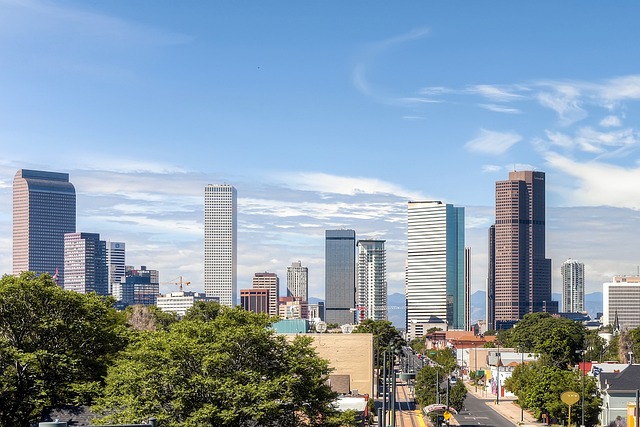In Denver, buildings constructed before 1978 may contain asbestos, a hazardous material that can cause severe respiratory illnesses like mesothelioma, lung cancer, and asbestosis upon exposure. The city's climate exacerbates the risk of asbestos fiber release during maintenance or renovation. Asbestos Removal Denver offers professional services to address this issue, utilizing specialized techniques and technology to ensure safe removal and disposal of asbestos-containing materials, in compliance with stringent local regulations. These services are essential for maintaining public health and safety, as they adhere to the meticulous protocols set by the Colorado Department of Public Health and Environment and the Environmental Protection Agency. The process includes thorough inspections, containment measures, careful removal, and rigorous post-remediation cleaning and air quality testing to ensure a safe environment for reoccupation. Asbestos Removal Denver's practices are crucial for protecting residents from the pernicious health effects of asbestos exposure.
Asbestos, a hazardous material once lauded for its fire-retardant properties, now poses significant health risks to Denver residents. Its presence in many older buildings across the city underscores the need for Asbestos Removal Denver services. This article delves into the dangers lurking within Denver’s structures, the health consequences of asbestos exposure in Colorado’s unique climate, and the comprehensive legal and regulatory standards guiding its removal. With a focus on safe practices for handling this hidden threat, homeowners and workers can safeguard their health and comply with local regulations. Understanding the critical role of Asbestos Removal Denver services is not just about adhering to laws but also about protecting lives from the silent dangers of asbestos.
- Understanding Asbestos Hazards in Denver Homes and Environments
- The Health Implications of Asbestos Exposure in Colorado's Climate
- Legal and Regulatory Framework for Asbestos Removal in Denver
- Step-by-Step Guide to Safe Asbestos Removal Practices in Denver Properties
Understanding Asbestos Hazards in Denver Homes and Environments

Asbestos, a naturally occurring mineral, poses significant health risks when its fibers are disturbed and released into the air. In Denver, homes and structures built prior to the asbestos ban in 1978 may contain this hazardous material, making asbestos removal a critical concern for residents and property owners. Asbestos was once lauded for its fire-resistant and insulating properties, leading to its widespread use in building materials like insulation, flooring, and ceiling tiles. However, exposure to these fibers can result in serious health issues, including mesothelioma, lung cancer, and asbestosis – conditions that can be fatal. The unique climate of Denver, with its variation in temperature and weather patterns, can exacerbate the release of asbestos fibers during maintenance or renovation activities, underscoring the necessity for professional asbestos removal services in Denver.
Professional asbestos removal companies in Denver are equipped to handle this dangerous material safely and efficiently. They employ specialized techniques and technologies to identify, remove, and dispose of asbestos-containing materials without risking the health of individuals within the vicinity. Given the potential for exposure in older homes, schools, and commercial buildings, it is imperative to engage with experienced and certified asbestos removal contractors in Denver. These experts not only protect public health but also comply with stringent regulations that govern asbestos abatement. By prioritizing asbestos removal, Denver residents can safeguard their environments from the pernicious effects of this silent hazard, ensuring a safer and healthier living space for all.
The Health Implications of Asbestos Exposure in Colorado's Climate

Asbestos, a naturally occurring mineral, has been widely used in construction and manufacturing due to its heat-resistant and insulating properties. However, its fibers are hazardous when disturbed and can pose significant health risks, especially in a climate like Colorado’s where extreme temperature fluctuations can release these fibers into the air. Prolonged exposure to asbestos has been linked to severe respiratory diseases, including mesothelioma, lung cancer, and asbestosis. The arid conditions of Denver, with its low humidity, can actually cause asbestos particles to become airborne more easily than in more humid environments. This makes the risk of exposure and its consequent health implications even more pronounced for residents and workers. Therefore, it is imperative for homes, commercial buildings, and industrial sites undergoing renovation or demolition to engage in Asbestos Removal Denver practices to mitigate these risks. Professionals equipped with the right knowledge and tools can safely remove asbestos-containing materials, thereby protecting public health and ensuring compliance with state and federal regulations. Regular monitoring of asbestos levels and adherence to strict safety protocols are essential for preventing exposure and safeguarding the well-being of individuals living in or visiting affected areas.
Legal and Regulatory Framework for Asbestos Removal in Denver

In Denver, asbestos removal is governed by a comprehensive legal and regulatory framework designed to protect public health and safety. This framework includes local, state, and federal regulations that dictate how asbestos-containing materials (ACMs) must be identified, handled, and removed. The Colorado Department of Public Health and Environment, along with the Environmental Protection Agency (EPA), sets strict guidelines for asbestos abatement to prevent exposure during renovation, demolition, or maintenance activities in both residential and commercial settings. In adherence to these regulations, Asbestos Removal Denver companies are required to be trained and licensed to perform asbestos-related work. They must follow rigorous protocols for safe removal and disposal to ensure that the harmful fibers do not become airborne, where they can pose a significant health risk. These measures are critical, as asbestos exposure can lead to severe respiratory conditions like mesothelioma and lung cancer. Compliance with these regulations is not only legally mandated but also essential for maintaining environmental quality and safeguarding the well-being of Denver’s inhabitants. As such, engaging professional services for Asbestos Removal Denver becomes not just a compliance necessity but a responsible action for property owners and contractors alike.
Step-by-Step Guide to Safe Asbestos Removal Practices in Denver Properties

When tackling asbestos removal in Denver properties, it’s imperative to adhere to stringent safety protocols due to the significant health risks associated with asbestos fibers. The City of Denver has specific regulations that guide the safe handling and disposal of asbestos-containing materials (ACMs). A thorough understanding of these regulations is crucial for any individual or company undertaking asbestos removal in Denver.
The first step in the process involves a detailed assessment by a licensed asbestos inspector to identify and sample any suspect materials. This inspection determines the scope of the abatement project, ensuring that all areas containing asbestos are accurately mapped out for safe removal. Once the extent of the asbestos is known, the next step is to develop a comprehensive plan, which includes containment strategies to prevent the release of asbestos fibers into the air. This plan must be approved by the Denver Department of Environmental Health before any work commences.
Professional asbestos removal teams in Denver must then carefully isolate the affected areas using plastic sheeting and negative pressure units to trap contaminants. Personal protective equipment (PPE) such as respirators, gloves, and disposable suits are essential for the safety of workers. The actual removal process is meticulous, involving wetting or encapsulation techniques to minimize fiber release during the disturbance of ACMs. After careful removal, the waste must be double-bagged and clearly labeled for transport to a certified landfill. Post-remediation, all containment barriers are removed, and the area undergoes thorough cleaning and air monitoring to ensure it is safe for reoccupation. Finally, the project culminates in a comprehensive report documenting all steps taken, ensuring full compliance with local regulations and establishing a clear record for future reference. This meticulous process is non-negotiable for protecting public health and complying with asbestos removal regulations in Denver.
When addressing asbestos concerns in Denver, proactive measures are crucial. The potential hazards posed by this material underscore the necessity for specialized asbestos removal services, ensuring both public health and legal compliance. Understanding the health implications associated with asbestos exposure, particularly within Colorado’s unique climate, highlights the importance of professional interventions like those provided by Asbestos Removal Denver. Adhering to the stringent regulatory framework in place not only protects residents but also aligns with state mandates. With a comprehensive approach to safe removal practices, Denver property owners can safeguard their homes and well-being effectively. In light of these considerations, engaging reputable asbestos removal professionals is essential for maintaining a healthy environment in the Mile High City.
